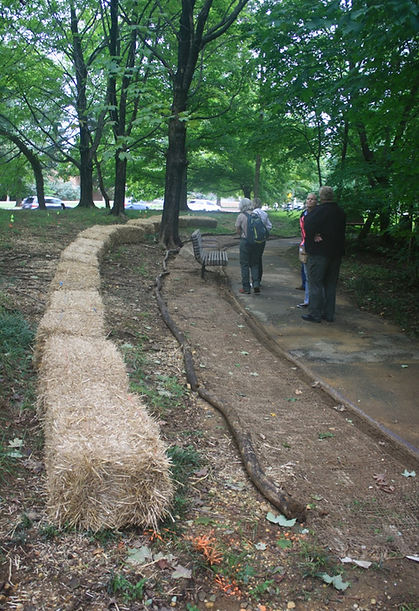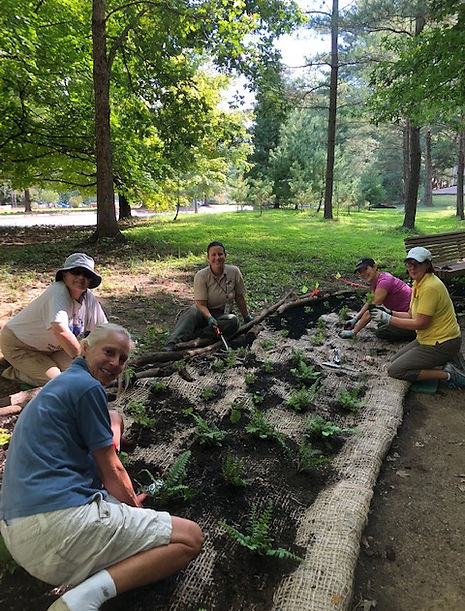
News & Views
Tawes Native Plants Erosion Control
Demonstration Garden
November 1, 2018
As a gardener, I venerate rainwater. However, constant yielding to, working with, and attempting to channel the effects of rainwater runoff at the base of a slope on the path toward the back of Tawes Garden was a sign that the area could use some intervention. The slick muddy erosion sediment caused by rain storms earned this area its nickname, “Mud Alley.” When rainwater runoff resulted in tricky walking conditions, it was my duty to clear the path and make it safe.
After one such storm, a friendly Tawes DNR staff member greeted me and expressed his regret that I was again stuck with another Sisyphean path shoveling detail. “Do you know anything about erosion control?” I asked the kind staff member. “Yes, I’m Kevin Smith, Director of the Office of Restoration & Resiliency, of the Chesapeake and Coastal Services. Believe me, I know about erosion control!”
That moment was the beginning of an alliance formed between Tawes Garden and Chesapeake and Coastal Services. Tawes now has a Native Plants Erosion Control Demonstration Garden. Its design was a collaborative effort between Sarah Hilderbrand Restoration specialist with CCS, and me, Tawes Garden Horticulturist Suzanne Weber. The Tawes Friend’s Board and garden manager Ranger Jay Myers approved the project which was funded by The Chesapeake and Atlantic Coastal Bays Trust Fund.
Thanks to the assistance of Master Gardener volunteers, Sandy Point rangers, Conservation Job Corps interns, and 12 CSS staff members, the garden’s installation took place in October 2018.
Before work began, the slope was sparsely vegetated by weeds and invasive plants. It’s location under valuable mature trees limited plant selection to herbaceous plants that grow well in shady conditions. Over time, mowing and foot traffic on the hill combined with intense rainstorms had washed away the topsoil, leaving only erodible mineral soils behind.
The Tawes Native Plants and Erosion Control Demonstration Garden preparation started with clearing weeds and lining the upper edge of the garden with 30 hay bales (a temporary runoff reduction while roots get established). Jute fabric was pinned over a 3 inch layer of organic soil conditioner spread over 450 square feet. On October 3, 2018, 19 volunteers and staff members planted 465 native plants in the garden, through jute mat, leaf gro, and into the rocky subsoil. The roots of native Christmas and cinnamon ferns, wood asters, woodland phlox, blue eyed grass, coreopsis, and mist flowers will spread over time and create a fibrous mat through the soil. Subsequently, the plant root mass will hold together, rebuild and protect the topsoil from the effects of rainwater erosion and washout. A 100 foot length 5 inch depth trench along the path was filled with a 10 inch diameter burlap cylinder – hand loaded with leaf gro, using a burrito type wrapping method. Creeping phlox and golden ragwort plants were planted in the leaf gro burrito in 1 foot intervals. A plastic landscape edge (perforated to prevent a soup bowl effect) was added as additional protection while roots establish in the burlap edging during the garden’s first year.


If you live in the Chesapeake Bay watershed and have a similar issue with rainwater runoff and erosion in your yard, we especially invite you to stop by and see how the Tawes erosion control native plants demonstration garden is coming along. Make judgements about what will work in your garden based on our successes and challenges. In 2019 we plan to have an interpretive sign attached to the public bench. We welcome you to sit, observe, and consider what aspects of the Tawes Garden design might be beneficial to managing rainwater in your garden. If you would like a guided tour, please call 410-260-8185 to make arrangements.
by Suzanne Weber,
Tawes Garden Horticulturist
